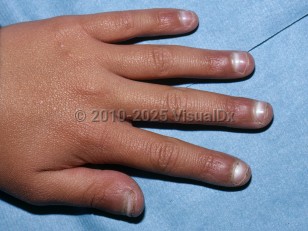Tetralogy of Fallot in Child
Alerts and Notices
Important News & Links
Synopsis

Rare congenital heart disease distinguished by a combination of 4 heart defects: ventricular septal defect, pulmonary stenosis, overriding aorta, and right ventricular hypertrophy. Typically diagnosed during infancy or shortly thereafter. Presentations depend on the severity of outflow obstruction.
Cyanosis is a very important clinical sign. An infant with unrepaired tetralogy of Fallot may have "tet spells" in response to activities such as crying or having a bowel movement; these spells occur when blood oxygen levels drop rapidly and the infant becomes cyanotic. Patient may be fussy, have difficulty breathing, become very tired or limp, or not respond to a parent's voice or touch. Heart murmur is a common clinical sign. Babies may have trouble feeding as they tire easily; therefore, they have difficulty gaining weight and growing at a normal pace. Children may have clubbed fingers. Patients are likely to have a chromosome disorder, such as Down syndrome or DiGeorge syndrome.
Possible complications include delayed growth and development, arrhythmias, seizures, and death.
Tetralogy of Fallot, although rare, is the most common type of cyanotic congenital heart disease. The precise cause of tetralogy of Fallot remains to be identified. Maternal factors may increase the risk, such as German measles infection or other viral illness, poor nutrition, alcohol use, age older than 40, and diabetes.
Surgery to repair heart defects is the definitive treatment and is often performed within the first year.
When diagnosed early and promptly followed by appropriate surgical treatment, the condition can be corrected and prognosis is good. Most patients who have undergone surgery as infants will typically live normal and healthy lives. However, some patients may require regular medical checkups or may have exercise restrictions. Without surgery, the risk of mortality increases as the patient ages; most patients do not live past their first or second decade.
Cyanosis is a very important clinical sign. An infant with unrepaired tetralogy of Fallot may have "tet spells" in response to activities such as crying or having a bowel movement; these spells occur when blood oxygen levels drop rapidly and the infant becomes cyanotic. Patient may be fussy, have difficulty breathing, become very tired or limp, or not respond to a parent's voice or touch. Heart murmur is a common clinical sign. Babies may have trouble feeding as they tire easily; therefore, they have difficulty gaining weight and growing at a normal pace. Children may have clubbed fingers. Patients are likely to have a chromosome disorder, such as Down syndrome or DiGeorge syndrome.
Possible complications include delayed growth and development, arrhythmias, seizures, and death.
Tetralogy of Fallot, although rare, is the most common type of cyanotic congenital heart disease. The precise cause of tetralogy of Fallot remains to be identified. Maternal factors may increase the risk, such as German measles infection or other viral illness, poor nutrition, alcohol use, age older than 40, and diabetes.
Surgery to repair heart defects is the definitive treatment and is often performed within the first year.
When diagnosed early and promptly followed by appropriate surgical treatment, the condition can be corrected and prognosis is good. Most patients who have undergone surgery as infants will typically live normal and healthy lives. However, some patients may require regular medical checkups or may have exercise restrictions. Without surgery, the risk of mortality increases as the patient ages; most patients do not live past their first or second decade.
Codes
ICD10CM:
Q21.3 – Tetralogy of Fallot
SNOMEDCT:
86299006 – Tetralogy of Fallot
Q21.3 – Tetralogy of Fallot
SNOMEDCT:
86299006 – Tetralogy of Fallot
Differential Diagnosis & Pitfalls

To perform a comparison, select diagnoses from the classic differential
Subscription Required
Best Tests
Subscription Required
References
Subscription Required
Last Updated:01/24/2022
Tetralogy of Fallot in Child

